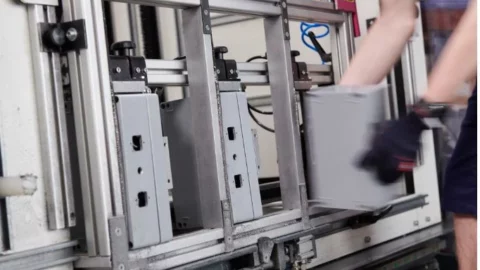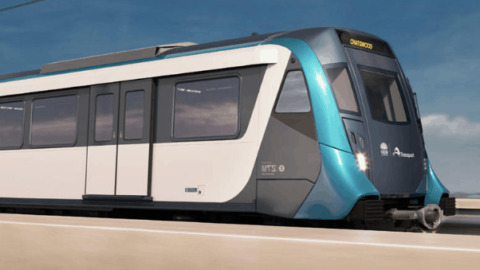by the Australian Rail Track Corporation Network (ARTC)
Advanced Train Management System (ATMS) is a modern, communications-based, safe-working system for the ARTC, which has been custom engineered for Australian conditions by ARTC and technology partner Lockheed Martin. It enhances the operation of the national interstate rail network, and provides a quantum leap forward in safety, capacity and productivity for freight rail operations.
ATMS replaces traditional trackside signalling equipment and implements intelligent software technology that allows information to be directly shared digitally between ARTC’s Network Control Centre and a train-borne unit on board a locomotive via mobile telecommunications.
The evolution of ATMS
After more than a decade of intense development, testing and design – a cutting-edge train management system has gone ‘live’ in South Australia.
The Advanced Train Management System (ATMS) has completed its final commissioning trials into service and is now the train control system for ‘live’ train services between Port Augusta and Whyalla in South Australia.
The system also has larger ramifications for the national rail network as it will eventually be rolled out nationwide, with work on the next phase along 1,700km of track between Port Augusta and Kalgoorlie already underway.
The Federal Government’s showpiece freight rail infrastructure project – the Inland Rail between Melbourne and Brisbane – will also be ATMS-ready when each section begins operation.
Recently-appointed Australian Rail Track Corporation (ARTC) Chief Executive Officer, Mark Campbell, said this is an important step in the process of upgrading the national network with proven technology that boosts safety, capacity, reliability and enhances the customer experience.
“The Interstate Rail Network is the backbone of our freight system and it’s crucial we have the latest systems and technology available to serve our customers well into the future, especially with the Inland Rail coming online,” Mr Campbell said.
“This will revolutionise the way we manage rail freight services by increasing capacity and improving operational flexibility, safety and reliability.
“ARTC is extremely proud of ATMS which has been ten-years in development. This product has been Australian made to benefit the people of Australia.
“This system has been developed from the ground up for Australian conditions. It has been tested under Australian conditions on the South Australian network. It has undergone rigorous testing before we brought the system into operation in August and it has passed every test.”

The ATMS train-borne unit inside a locomotive allows information to be directly shared between ARTC’s
Network Control Centre with the train driver via satellite (GPS), broadband and mobile telecommunications.
Moving freight from road to rail
Mr Campbell said further benefits and applications will continue to be incorporated as the ATMS is rolled out to new areas.
“Benefits for our customers will continue to flow as we continue to integrate new features such as fuel and energy management systems, as well as better timetabling of trains through the increases of capacity on the network that ATMS will enable,” he said.
“ARTC has ensured that industry has been at the forefront of consultation during the development of ATMS and we will continue to ensure that this system delivers substantial benefits to our customers.
“Moving more freight from road to rail will benefit the nation as our freight task continues to escalate. To be the mode of choice, rail needs to introduce cutting-edge technologies. ATMS is a key step in that objective.”
Harnessing digital technologies
The Australian Government has invested $50 million into the development of the system alongside investment from ARTC and Lockheed Martin.
“While rail already has an impressive safety record, ATMS harnesses digital technologies to reduce risk across the rail network even further,” Mr Campbell said.
ATMS is capable of automatically applying the train’s brakes where an overspeed has occurred and when predicting the train will exceed its end of authority should a train fail to take appropriate action for the conditions at hand.
For example, ATMS can enforce a train to a stop before it passes an end of authority displaying a stop indication, or before diverging on a switch which is improperly lined, thereby averting a potential collision.
“This system has an automatic safety intervention which provides the ability to apply a train’s brakes which prevents a train from exceeding the section of track it has permission to operate within,” Mr Campbell said.
“ATMS will prevent a range of potential issues such as train-to-train collisions, overspeed derailments and authorised incursions into an established work zone. It also means all ATMS equipped locomotives will ‘talk’ to each other to allow ‘fleeting’ to improve productivity.”

The ATMS system simplifies and streamlines the processes for ARTC’s Network Control Centre
and reduces the risk of human error.
Supporting increased demand
Mr Campbell said Australia’s nine leading rail freight businesses identified ATMS as the priority train control project to advance industry as a whole.
Between 2011 and 2031, the total domestic land freight task is expected to grow by 80 per cent. This is being driven by unprecedented population growth, coupled with increased demand from our trading partners in Asia and rapid changes in technology, e-commerce and consumer behaviour.
Without investment and reform to increase capacity and better manage demand, the annual cost of congestion in our capital cities could exceed $53 billion by 2031 underlining the need for better rail infrastructure to combat the growth in the freight task and the impact on road systems.
“The rail freight industry and the Federal Government are working closely together to explore the opportunities to accelerate ATMS implementation across the interstate rail network,” Mr Campbell said.
“This is being done through the Freight on Rail Group (FORG) which is reporting on progress to the Deputy Prime Minister, Michael McCormack.
“Rail is an essential part of the freight supply chain and the COVID-19 pandemic has shown just how much we rely on our rail network to support vital domestic trade and manufacturing supply chains.
“With freight demand set to increase, shifting long-haul freight from road to rail is a strategic priority and part of the Australian Government’s broader agenda for a resilient, efficient and sustainable national freight and supply chain network.
“The operation of ATMS marks a leap forward in train control, not only in Australia, but for the rail freight industry worldwide.”
Real-time information
Pacific National Operations Supervisor, Bernie Reid, said after consulting drivers utilising ATMS there were many identified benefits.
“The system is easy to use and understand, and there is no need to contact train control and provide times at locations which limits some of the distractions. There is also no need to raise or take a written train working authority, which means less paperwork,” Mr Reid said.
“Once we have entered the information ‘it’s set up and off we go’. Also having the ability to see up to 10km ahead to view oncoming services, any speed restrictions on the line or track worker authorities is a real benefit. The system provides real-time information and feedback with drivers looking forward to interacting with other trains and services.”
Mr Reid added that in the future ATMS will allow for trains to follow each other and have an increased safety aspect.
















